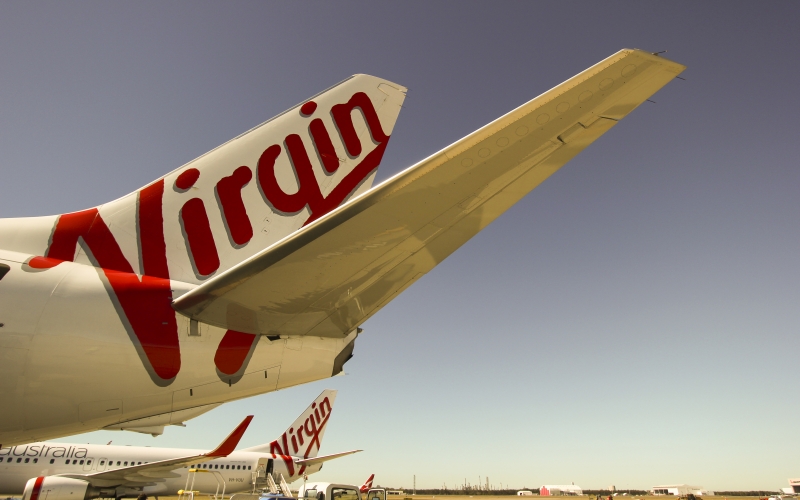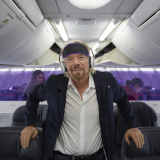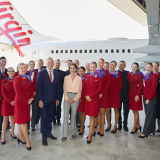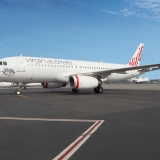Virgin Australia Holdings Limited (ASX: VAH) FY17 Results

Virgin Australia Holdings Limited (ASX: VAH) FY17 Results: Stronger Cash and Balance Sheet, Statutory and Underlying Loss, Outlook Improving1
Summary of FY17 Financial Outcomes
• Group Underlying Loss Before Tax of $3.7 million – with a significant improvement in performance in Q4 FY17, up $38.4 million on Q4 FY16
• Group Statutory Loss After Tax of $185.8 million – an improvement of $38.9 million on FY16, impacted by restructuring charges predominantly from the Better Business program
• Positive Free Cash Flow of $34.3 million – an improvement of $126.4 million on FY16
• Closing total cash balance of $1,396.1 million as at 30 June – an improvement of $272.3 million on end of FY16
• Net Debt reduction of $839.0 million – including $260.0 million in accelerated debt repayments
• Financial Leverage improvement of 14.1 per cent on 30 June 2016 to 4.5x at 30 June 2017
• Better Business program implementation ahead of schedule. Savings target increased to $350 million per annum in annualised net free cash flow savings by the end of FY19
• Outlook for FY18: Given underlying performance improvement in Q4 and based on current market conditions, the positive momentum seen in Q4 FY17 is expected to continue and underlying performance for Q1 FY18 is expected to improve compared to Q1 FY17. The Group also expects the Better Business program to continue to track ahead of schedule in implementation and expects further balance sheet improvements to be delivered.
FY17 Segment Outcomes
• Virgin Australia Domestic Q4 FY17 underlying performance improved compared to Q4 FY16, with overall FY17 Underlying EBIT performance of $92.9 million, impacted by subdued trading conditions.
- Disciplined domestic capacity management with 5.9 per cent decline in sectors flown
- Led major competitor in domestic On Time Performance for the past three financial years
• Virgin Australia International business profitable, delivering $49.3 million improvement in Underlying EBIT as well as yield and RASK growth
• Tigerair Australia domestic operations profitable, overall Tigerair Australia underlying performance (including international) impacted by Bali operations
• Velocity Underlying EBIT performance improved 2.2 per cent on FY16, with business significantly exceeding its FY17 membership target to reach 8 million members by 30 June 2017
• Achieved ‘Best Airline’ and ‘Best Airline Staff’ in the Australia/Pacific region at the World Airline Awards, ‘Best Business Class’ at the Airline Ratings ‘Airline of the Year’ awards and ‘Best Domestic Airline’ at the National Travel Industry Awards
• Following customer testing period in FY17, Virgin Australia to rollout inflight wireless internet to its Boeing 737, Boeing 777 and Airbus A330 fleets.
FY17 Results Commentary
10 August 2017: Virgin Australia Group Chief Executive Officer John Borghetti said: “Throughout the 2017 financial year, the Virgin Australia Group maintained a strong focus on improving its balance sheet which is yielding positive results. Today, we reported the first positive free cash flow result since the 2012 financial year and the Group’s highest reported cash balance as at 30 June. We have also delivered a 40.0 per cent improvement in Financial Leverage compared to the end of the 2014 financial year following an $839 million reduction in Net Debt.
“The Group also concluded the first year of our three year Better Business program, which is designed to reduce our cost base, enhance our cash flow and improve our capital position. I am pleased to report that we are ahead of schedule with the program’s implementation and today I can announce that we are increasing the savings target for the program. The program is now on track to deliver $350 million per year in annualised net free cash flow savings by the end of the 2019 financial year, a $50 million per annum increase on the original savings target.
Group underlying and statutory performance
“The Group’s underlying performance for the 2017 financial year was affected by subdued domestic trading conditions and the impact of fleet simplification.
“However, in line with our previous guidance, we are beginning to see some positive results in our underlying performance, with the Group’s underlying performance for the fourth quarter of the 2017 financial year improving by $38.4 million on the prior corresponding period.
“The Group’s statutory result was impacted by restructuring charges predominantly from the Better Business program. While there are upfront costs associated with implementing the program, it will deliver significant, long-term cash flow savings.
Segment performance
“Virgin Australia Domestic’s performance was impacted by subdued trading conditions including reduced demand for regional travel and for corporate travel. We managed capacity prudently in response to these conditions, with sectors flown declining by 5.9 per cent on the prior financial year. Pleasingly, the underlying performance of Virgin Australia Domestic improved in the fourth quarter of the financial year in comparison to the prior corresponding period.
“Virgin Australia International was profitable for the 2017 financial year, a result supported by growth in yield and unit revenue. These positive outcomes have been driven by the international improvement strategy that the Group commenced two years ago.
“Tigerair Australia’s domestic operations were also profitable, with the business delivering passenger and unit revenue growth. Tigerair’s overall underlying performance, including international operations, was impacted by the launch and withdrawal of operations to Denpasar (Bali).
“Velocity continued on its growth trajectory, significantly exceeding its 2017 financial year membership target to reach over eight million members. This is an exceptional achievement, with the program now counting the equivalent of one in three Australians as members. Velocity also improved its underlying profitability this year and forged a number of important new partnerships, including deals with Flybuys, Energy Australia and Bupa.
Excellence in customer experience, product and network
“Throughout the 2017 financial year, the Virgin Australia Group continued to bring strong competition to all parts of the Australian aviation industry. In particular, we have worked to ensure that we offer differentiated and rewarding travel experiences that will continue to attract customers across every segment of the aviation market. Virgin Australia made significant progress on connecting Australia and Greater China by launching the sale of direct services to Hong Kong in March 2017 and commencing our proposed alliance with HNA’s aviation businesses. Virgin Australia also expanded operations to the United States market, with the launch of Melbourne – Los Angeles flights in April 2017.
“The business also remained focused on improving the customer experience, with the launch of game-changing initiatives such as EconomyX, which has been very well received by customers and is yielding revenue growth for the company. Meanwhile, Tigerair Australia continued to grow its position in the low cost travel market by expanding its domestic network to a number of new destinations and introducing customer experience enhancements including mobile boarding passes and the completion of the T4 terminal at Melbourne Airport. Going forward, the Virgin Australia Group will continue to bring choice and innovation to travellers, and I am pleased to announce today that we will roll out inflight wireless internet to Virgin Australia’s Boeing 737, Boeing 777 and Airbus A330 fleets.
“I would like to sincerely thank our people for their unwavering focus on delivering a rewarding experience for our customers, while ensuring we meet our Better Business program targets. Their passion and dedication has seen the Group recognised on the world stage, with Virgin Australia named as the ‘Best Airline’ and in the Australia/Pacific region at the World Airline Awards this year. Virgin Australia’s staff were also named as ‘Best Airline Staff’ in the Australia/Pacific region at those awards, the fifth time in six years that they have received this accolade.
Focus and outlook for the 2018 financial year
“As we move into the 2018 financial year, we will remain firmly focused on continuing the strong momentum of the Better Business program to deliver sustainable cash flow savings. We will also consolidate the position we have established in the domestic market, manage capacity in response to demand, and leverage opportunities in the growing Asian and North American markets. Ensuring that we continue to deliver a safe and rewarding travel experience to all of our guests is central to achieving this. It is also important that we continue to strengthen our financial foundation by continuing the positive trajectory on cash, further reducing debt and improving leverage. These actions will support future earnings growth and the delivery of long-term value for all of our shareholders.
“Given underlying performance improvements in the fourth quarter of the 2017 financial year and based on current market conditions, we expect the positive momentum seen in the fourth quarter to continue and that underlying performance for the first quarter of the 2018 financial year will improve compared to the first quarter of the 2017 financial year.
The Group also expects the Better Business program to continue to track ahead of schedule in implementation and expects further balance sheet improvements to be delivered,” Mr Borghetti said.
Group-wide Financial Results
Revenue and costs
Group revenue was $5,047.3 million, an improvement of $26.3 million on the 2016 financial year.
Group Cost per Available Seat Kilometre increased by 2.2 per cent on the 2016 financial year as a consequence of costs associated with fleet simplification and reduction in capacity to meet subdued trading conditions.
Restructuring charges
The Group’s statutory result for the 2017 financial year was impacted by restructuring charges predominantly related to the Better Business program, with the majority of charges related to fleet restructuring, fleet impairments and organisational rightsizing.
Update on Better Business program
Progress on the implementation of the Better Business program in the 2017 financial year included:
• 5 per cent reduction in operating fleet with capacity maintained through improved utilisation of aircraft;
• the sale of 10 E190 aircraft and lease return of 2 E190 aircraft2;
• a wind down of E190 operations, which are due to cease at the end of the 2017 calendar year;
• a reduction in ATR operations and identification of up to eight ATR aircraft to be removed from fleet;
• renegotiation of a number of Boeing 737 leases on more favourable terms;
• optimisation of domestic and international flight networks, including the exit of loss-making routes including Abu Dhabi;
• implementation of additional fuel saving initiatives;
• implementation of efficiencies in maintenance including installation of carbon brakes and onshoring of maintenance services; and
• organisational rightsizing.
Fuel and foreign currency
For the 2018 financial year, the Group is highly hedged against adverse movements in fuel prices and foreign exchange rates while maintaining reasonable participation in favourable movements.
Segment performance
Virgin Australia Domestic
Virgin Australia Domestic’s revenue and yield performance were impacted by subdued trading conditions. The business exercised disciplined capacity management in response, with sectors flown declining by 5.9 per cent on the prior financial year. Yield declined by 1.5 per cent and RASK declined by 0.2 per cent compared to the 2016 financial year. Underlying EBIT for Virgin Australia Domestic was $92.9 million.
However, the underlying performance of Virgin Australia Domestic in the fourth quarter of the financial year showed improvement compared to the prior corresponding period.
Throughout the year, the Virgin Australia Group continued to enhance and differentiate its domestic customer experience. The business introduced EconomyX, an extra legroom seating product that is unique to the Australian aviation market and is delivering revenue growth with a strong penetration among guests. Virgin Australia Domestic was the most on time major domestic airline in the 2017 financial year and has now led its major competitor in On Time Performance for the past three financial years.
Virgin Australia International
Virgin Australia International reported a profitable Underlying EBIT result of $0.5 million, in line with 2017 financial year targets and a $49.3 million improvement on the 2016 financial year. Virgin Australia International’s RASK grew by 1.4 per cent and Yield grew by 2.1 per cent on the previous year.
These outcomes are the result of the international improvement strategy that has been implemented over the past two years. During this period, Virgin Australia International has withdrawn from the loss-making markets of Phuket, some routes to Denpasar (Bali) and Abu Dhabi and expanded to growth markets by commencing Melbourne–Los Angeles services in April 2017 and Melbourne–Hong Kong services in July 2017. The airline also completed the rollout of its award-winning business class product on the Boeing 777 fleet, which supported yield and unit revenue improvement.
Tigerair Australia
Tigerair Australia reported an Underlying EBIT loss of $24.3 million, representing a decline of $26.5 million on the 2016 financial year. This result was impacted by the costs associated with the launch and withdrawal of flights to Denpasar (Bali). Excluding the impact of the Denpasar operations, the underlying performance of Tigerair’s domestic operations was profitable in line with 2017 financial year targets.
Passengers carried by Tigerair grew by 10.7 per cent and RASK grew by 3.6 per cent on the prior financial year. Passenger growth outpaced Available Seat Kilometre growth of 10.2 per cent. Tigerair’s capacity growth over the year was driven by operations to Denpasar and the comparative impact of the addition of a fourteenth Airbus A320 aircraft.
Tigerair Australia was the most on time low cost carrier in the 2017 financial year and has now led its major competitor in On Time Performance for the past three financial years.
Velocity
Velocity reported revenue of $371.0 million, a 13.2 per cent increase on the 2016 financial year. Velocity’s underlying performance in the first half of the year was impacted by investment in technology, new partnerships and internal resources to position the business for future growth. However, Underlying EBIT performance in the second half improved on the first half, with Velocity delivering a full year Underlying EBIT performance improvement of 2.2 per cent compared to the prior financial year.
Velocity’s growth in membership was supported by an average daily join rate of 4689 people across the 2017 financial year. Velocity continued to add earning and redemption partners for a diverse portfolio of more than 400 brands.
In April 2017, Velocity was awarded ‘Best Redemption Ability’ in the Middle East and Asia/Oceania region for the fifth consecutive year at the 2017 Freddie Awards. Velocity was also awarded ‘Best Elite Program’ in the Middle East and Asia/Oceania region.
Rollout of inflight wireless internet
Further information on the rollout of inflight wireless internet across Virgin Australia’s fleet is available in the separate media release issued today.
Notes:
(1) Operating statistics are issued on a preliminary basis and are subject to change. Any adjustments made will flow through to the year to date results.
(2) Revenue Passenger Kilometres or RPKs is a non-statutory measure derived from the number of paying passengers multiplied by the number of kilometres flown on Virgin Australia or Tigerair Australia operated flights.
(3) Available Seat Kilometres or ASKs is a non-statutory measure derived from total number of seats available for passengers multiplied by the number of kilometres flown on Virgin Australia or Tigerair Australia operated flights.
(4) Revenue Load Factor is a non-statutory measure derived from RPKs as a percentage of ASKs.
Disclaimer
The non-IFRS information defined below has not been audited or reviewed by KPMG.
This document has not been audited or reviewed by KPMG; however, IFRS data has been derived from the unaudited annual consolidated financial statements that are in the process of being audited by KPMG.
Definitions
Virgin Australia Domestic: Please refer to the Group’s ASX Appendix 4E and Preliminary Final Report for the financial year ended 30 June 2017 for the definition of this term.
Virgin Australia International: Please refer to the Group’s ASX Appendix 4E and Preliminary Final Report for the financial year ended 30 June 2017 for the definition of this term.
Tigerair Australia: Please refer to the Group’s ASX Appendix 4E and Preliminary Final Report for the financial year ended 30 June 2017 for the definition of this term.
On Time Performance: Reflects data from Bureau of Infrastructure, Transport and Regional Economics (BITRE) about the percentage of all VA, TT, QF and JQ designated services flown in Australia from July 2014 to June 2017 inclusive that departed within 15 minutes of scheduled departure times.
Underlying Profit / (Loss) Before Tax: is a non-statutory measure that represents statutory profit / (loss) before tax excluding the impact of impairment losses on assets classified as held for sale, impairment losses on other assets, onerous contract expenses, business and capital restructure and transaction costs (as defined below), share of net profits of equity-accounted investee and the impact of hedging and financial instruments (as defined below). This is a measure used by Management and Board of Virgin Australia Holdings Limited (VAH) to assess the financial performance of VAH.
Underlying Performance: is a non-statutory measure that refers to earnings or returns calculated based on Underlying Profit / (Loss) Before Tax (as defined above).
Business and capital restructure and transaction costs: is a non-statutory measure that includes business and capital restructure and transaction costs.
Hedging and financial instruments: is a non-statutory measure that includes the following items outlined in Note 2 of the VAH Preliminary Final Report. For the year ended 30 June 2017: time value movement on cash flow hedges (loss of $43.5m), unrealised ineffectiveness on cash flow hedges and non-designated derivatives (gain of $0.7m). For the year ended 30 June 2016, this item includes: time value movement on cash flow hedges (loss of $28.5m) and unrealised ineffectiveness on cash flow hedges and non-designated derivatives (gain of $0.7m).
Underlying Earnings Before Interest, Tax, Depreciation, Amortisation and Aircraft Rentals (EBITDAR): is a non-statutory measure per Note 2 of the VAH Preliminary Final Report for the year ended 30 June 2017. It is used by Management and VAH’s Board as a measure to assess the financial performance of VAH and its individual segments. It is defined as Underlying Profit / (Loss) Before Tax (as defined above) excluding the impact of depreciation, amortisation, aircraft rentals and net finance costs.
Underlying Earnings Before Interest & Tax or Underlying EBIT: is a non-statutory measure per Note 2 of the VAH Preliminary Final Report for the year ended 30 June 2017. It is used by Management and VAH’s Board as a measure to assess the financial performance of VAH and its individual segments. It is defined as Underlying Profit / (Loss) Before Tax (as defined above) excluding the impact of net finance costs.
Underlying Earnings Before Interest & Tax Margin or Underlying EBIT Margin: is a non-statutory measure derived from Underlying Earnings Before Interest & Tax (as defined above) divided by total segment revenue.
Free Cash Flow: is a non-statutory measure derived from cash generated from operating activities (excluding finance costs and finance income) less cash payments for business restructuring expenses less net cash used in investing activities less equity distributions paid to non-controlling interests.
RASK: is a non-statutory measure derived from segment revenue normalised for Cargo operations on a consistent basis divided by Available Seat Kilometres (defined above) of the regular passenger transport business.
Group Cost per Available Seat Kilometre or Group CASK: is a non-statutory measure derived from consolidated segment revenue less consolidated segment Underlying EBIT (as defined above) excluding fuel, hedging gains / (losses) on fuel, Velocity Frequent Flyer (VFF) segment costs, foreign exchange gains / (losses) on non-fuel costs and normalising for Cargo operations on a consistent basis divided by Available Seat Kilometres (defined above) of the regular passenger transport business. Group CASK is reported on a sector length adjusted basis.
Yield: is a non-statutory measure derived from segment revenue normalised for Cargo operations on a consistent basis divided by Revenue Passenger Kilometres of the regular passenger transport business.
Financial Leverage: is a non-statutory measure and is defined as the ratio of Adjusted Net Debt (as defined below) to EBITDAR (as defined above).
Adjusted Net Debt: is a non-statutory measure derived from Net Debt (as defined below) adding 7 times annual aircraft rentals.
Net Debt: is a non-statutory measure derived from interest bearing liabilities less cash and cash equivalents.
Forward Looking Statements: This document contains certain forward looking statements. Forward looking statements can generally be identified by the use of words such as ‘project’, ‘foresee’, ‘plan’, ‘expect’, ‘aim’, ‘potential’, ‘goal’, ‘target’, ‘intend’, ‘anticipate’, ‘believe’, ‘estimate’, ‘may’, ‘could’, ‘should’, ‘will’ or similar expressions. Indications of, and guidance on, future earnings and financial position and performance are also forward looking statements. Forward looking statements, opinions and estimates provided in this document involve a number of risks, assumptions and contingencies, many of which are beyond the Virgin Australia Group’s control and which are subject to change without notice, as are statements about market and industry trends, which are based on interpretations of current market conditions. It is believed that the expectations reflected in these forward looking statements, opinions and estimates are reasonable, but there can be no assurance that actual outcomes will not differ materially from these statements. Such forward looking statements, opinions and estimates are provided as a general guide only, should not be relied on as an indication or guarantee of future performance and speak only as of the date of this announcement. You should not place undue reliance on forward looking statements.
No representation or warranty, express or implied, is made as to the fairness, accuracy, completeness or correctness, likelihood of achievement or reasonableness of any of the information, forward looking statements, opinions and estimates contained in this document. To the maximum extent permitted by law, none of the Virgin Australia Group, its directors, employees or agents, nor any other person accepts any liability for any loss arising from the use of the information contained in this document. Except as required by law and ASX Listing Rules, the Virgin Australia Group has no obligation to update publicly or otherwise revise any forward looking statement, opinion or estimate as a result of new information, future events or other factors.
Nothing contained in this document constitutes investment, legal, tax or other advice. You should make your own assessment and take independent professional advice in relation to the information contained in this document and any action taken on the basis of that information.
ASIC guidance
In December 2011 ASIC issued Regulatory Guide 230. In order to comply with this Guide, Virgin Australia Holdings Limited is required to make a clear statement about whether information disclosed in documents other than the Virgin Australia Holdings Limited Preliminary Final Report for the year ended 30 June 2017 has been audited or reviewed in accordance with Australian Auditing Standards.
The above non-IFRS information has not been audited or reviewed by KPMG. This document has not been audited or reviewed by KPMG; however, IFRS data has been derived from the unaudited annual consolidated financial statements that are in the process of being audited by KPMG.
1For disclaimers and definitions of non-statutory financial terms and other capitalised terms, refer to page 7. This document should be read in conjunction with the Group’s ASX Appendix 4E and Preliminary Final Report for the financial year ended 30 June 2017 and the document entitled ‘Presentation – FY17 Financial Results’, which were released to the Australian Securities Exchange on 10 August 2017.
2The return of the second E190 aircraft was completed in July 2017.







